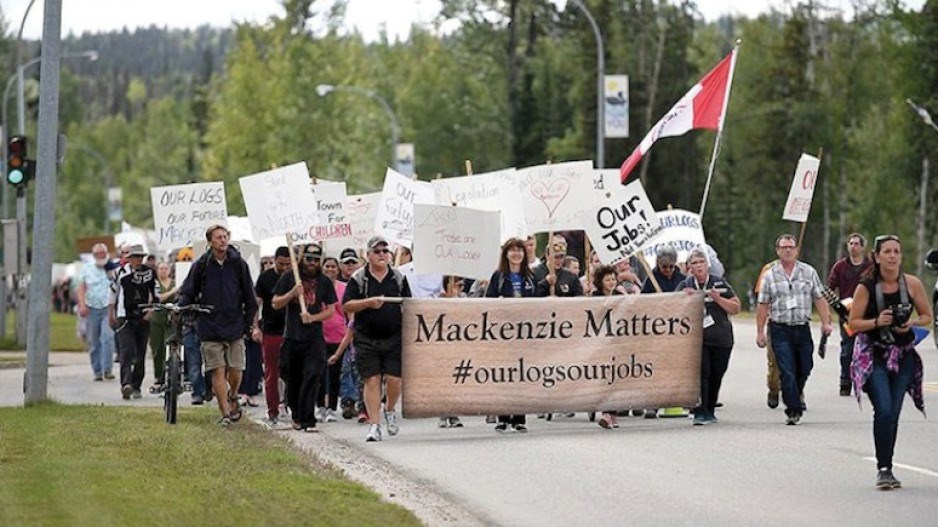For Vancouver real estate agent Bruce Long, the impact of the forestry fall-off in northern B.C. hit home this week as one of his clients axed the price of a 32-unit rental apartment building in Mackenzie. Again.
“We started off a year ago asking $2.49 million,” said Long of Macdonald Commercial. “Then it was lowered to $1.9 million, then $1.7 million. Now it is at $1.3 million. And they may take less.”
This works out to less than $41,000 per door for a townhouse complex that generates a gross income of $249,561 a year and throws a 7% capitalization rate, Long noted.
“The sellers are very motivated,” he said.
That motivation was underscored last week as hundreds of Mackenzie residents took to the streets of the northern Cariboo town to protest the shutdown of three sawmills, part of a deluge of closures, both permanent and temporary, hitting B.C.’s suffering forestry sector.
Mackenzie’s Canfor (TSX:CFP) sawmill closed July 19 and its Conifex (TSX:CFF) mill closed three weeks later but reopened September 3. A third sawmill closed for lack of wood.
The closures threaten 250 jobs in the community of 4,500 a short drive north of Prince George.
Philip Wysoski, a Conifex sawmill worker who was laid off along with his wife, Danielle Hildebrand, brought all four of their children with them on the August 26 march leading from the town’s Forest Ministry office to a rally at its recreation centre.
“We were told we’d be called back to work September 3 but we know we don’t have enough logs here to go back for double shifts,” said Wysoski, who grew up in Mackenzie.
Wysoski said he hoped the march and rally would draw enough attention to the plight of the logging town to ensure it’s still around when his children are adults.
“We need the government to open their eyes and realize what they’re doing to small communities like Mackenzie,” he told the Prince George Citizen.
In Fort St. John, the city’s single largest taxpayer and one of its biggest employers shut down August 9 as Louisiana-Pacific (NYSE:LPX) indefinitely stopped operations at its Peace Valley oriented strand board (OSB) mill.
The shutdown put 190 workers out of work.
The forestry industry is reeling from a loss of timber due to the pine beetle infestation and forest fires, and a recent downturn in the U.S. housing market.
B.C.’s forest industry contributes about $12 billion annually to the provincial GDP, of which about half comes from softwood lumber production. But the B.C. government estimates that the total timber supply will fall from an estimated 65.4 million cubic metres this year to 59 million cubic metres within five years and less than 55 million cubic metres in 10 years.
“Business is slow in town,” said Ron Rodgers, a broker with NorthEast BC Realty in Fort St. John, who said real estate sales are off 50% from a year ago. “Everybody seems to be on hold.”
Rodgers said the excited anticipation of a liquefied natural gas (LNG) boom has waned and the loss of forestry jobs has added to the angst.
The bad economic news follows on the heels of announcements that Norbord (TSX:OSB) will indefinitely shut its OSB mill in 100 Mile House, and that Canfor will curtail operations at all but one of its sawmills in B.C. Canfor shut down its Vavenby sawmill in July.
This week Interfor Corp. (TSX:IFP) announced the indefinite closure of its Hammond sawmill in Maple Ridge.
Back in Mackenize, B.C. Forests Minister Doug Donaldson was the first speaker to face the crowd at the March for Mackenzie rally.
“It’s not easy for a politician to stand in front of a community talking about tough times and challenges ahead but that’s what your community and others are dealing with,” Donaldson said. “The Interior forest industry is facing some challenging circumstances, and you and your community are feeling the brunt of it.”
He said it’s easy to suggest the government can simply reduce stumpage rates as a solution.
“But one needs to only take a look at the latest trade news to see how the current U.S. government would likely respond if our government or any government in Canada lowered stumpage rates,” Donaldson said.
Long said he remains confident that, like forestry and LNG, the real estate market in the north is also in a temporary lull.
When investors look at the current prices and the long-term potential, “now is a good time to be buying real estate in the north,” he said. •
– With files from Prince George Citizen




